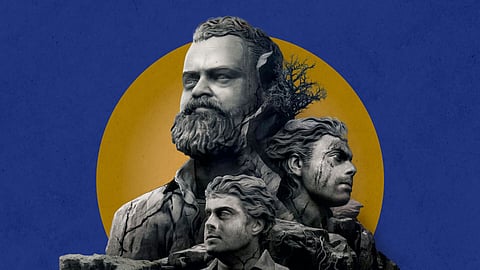
- Reviews
- Power List 2024
- Cannes 2024
- In-Depth Stories
- Web Stories
- News
- FC Lists
- Interviews
- Features
- FC SpecialsFC Specials

Director: Tinu Pappachan
Cast: Kunchacko Boban, Arjun Ashokan, Antony Pepe, Manoj K U, Sajin Gopu, Anuroop
Available in: Theatres
Duration: 129 minutes
The opening shot of Chaaver tells you a lot about the film you are going to watch. It’s of a rat trying to eat the head of a cockroach that’s crawling on a road. Just as you’re expecting the rat to gobble up the cockroach whole, it’s run over by a speeding vehicle, leaving behind a thin, long blood stain all across the screen. Much of Chaaver is set inside this speeding vehicle, but the film is very much an extension of the gory visuals we’ve just witnessed. It is set in politically-volatile Kannur where survival belongs only to the fittest. It is a visceral environment painted in many shades of red through Tinu Pappachan's glorious imagery. Yet its core is as animalistic as it can get with the film developing into a brutal food chain, exposing the hierarchies of a political mechanism.
To complement this idea of a dog-eat-dog universe, Tinu frames important moments in the presence of insects and animals. At times these are as harmless as the shot of a butterfly flying away. Yet in others, like when we see a lizard perched on the wall, these creatures appear to be the only witnesses to truths, providing reaction shots where there are only one kind of people.
These people include the cogs in a wheel that keeps the political machinery running. Like the titular Chaaver, the central characters in the film are martyrs or assassins who are willing to lose their lives for a mission. Yet what gives the film its sadness is just where these martyrs place themselves in this machinery, even if it means risking your life for a mission you are not even briefed about.
Written by Joy Mathew, one can include Chaaver too as a part of his trilogy that is all about human entrapment. In all three of his films, Shutter (2012), Uncle (2018) and now Chaaver, you find the central characters not just restricted to one physical location (a shop, or a vehicle) but also within the confines of what society expects of them. In Shutter, this is decency and in Uncle, this becomes a moral code between friends. If there was one emotion that underlines Chaaver, it is subservience, either to an ideology or a political party.
A highlight of this is felt in the way we travel through the duration of this without truly trusting the real identities of these four characters. While Ajayan (Arjun Ashokan) presents a close, outsider’s gaze into this world, we know almost nothing of the central characters. Their names—Ashokan (Kunchacko Boban), Mustafa, Thomas—appear to be there only to make a larger statement about how the system is all-encompassing without a religion. They seem to not have a origin either with Ashokan pointing at different wounds in his body and attributing them to the various hitjobs he has undertaken for the party in various parts of the State.
This serious core also gives Tinu Pappachan’s direction some emotional heft. Unlike the ultra-masculine universes they inhabit, in Chaaver these tough men possess a humane side. This is also the same with the few women in this film. A remarkable example is of the character played by Sangeetha. She plays Arjun Ashokan’s mother but even when the film separates his character from his mother, you never get to see Sangeetha panicking or stressing about her missing son. Not only does this reveal her inner strength, but also speaks about her husband and what must have happened to them. In a movie that talks about blind submission to a political party, you also see women like her who have been empowered by the ideology.
But this political commentary seldom affects Tinu’s original vision for a film. Not only do regular situations get elevated by Jinto George’s visuals but the sound design too by Ranganath Ravi, keeps the film at an unsettling space providing for deep discomfort even in beautiful locales. Yet you fail to understand why the film remains at a distance despite how mysterious these characters become. We know almost nothing about them and their motivations, given the risks they have put themselves into. But despite the mystery, they also begin to matter less with each passing minute. It’s as though the film only works in an abstract form with the characters not amounting to any real feeling. Yet what remained surprising, even as we are primed for the film to conclude with a major action block, is how ordinary it felt. These portions are meant to play out like a home invasion thriller with multiple attackers from the outside trying to get at the protagonists. But even here, instead of being enthralled by the ingenuity of a major shootout, we get stuck wondering how the attackers here are just like the protagonists, nameless and faceless, ready to pledge their lives for a pointless mission. In the end, Chaaver too remains a film we admire for its technical wizardry, even if its commentary should have resulted in a far more devastating film.